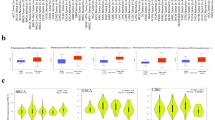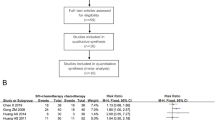Abstract
Purpose
Non-small cell lung cancer (NSCLC) is a complex disease that remains a major public health concern worldwide. One promising avenue for NSCLC treatment is the targeting of transcription factors that regulate key pathways involved in cancer progression. In this study, we investigated the role of the transcription factor ZNF263 in NSCLC and its impact on the regulation of IL33, apoptosis, and autophagy.
Methods
Levels of ZNF263 in tissues and cell lines were identified, after which the effects of its knockdown on cellular malignant behaviors, apoptosis and autophagy were assessed. Based on bioinformatics analysis, ZNF263 was found to bind to IL33 promoter, their mutual relationship was confirmed, as well as the role of IL33 in the regulation of ZNF263. The involvement of ZNF263 in the growth of xenograft tumors was assessed using tumor-bearing nude mouse models.
Results
Experimental results revealed that ZNF263 was upregulated in NSCLC tissue samples and cell lines. Its expression level is positively correlated with cellular malignant behaviors. We further demonstrated that ZNF263 upregulated IL33 expression, which, in turn, promoted the proliferation and migration, inhibited apoptosis and autophagy in NSCLC cells. Furthermore, ZNF263 knockdown reduced the growth of xenograft tumors in nude mice.
Conclusion
This finding suggests that the inhibition of ZNF263 or IL33 may represent a novel therapeutic strategy for NSCLC. Importantly, our results highlight the crucial role of transcription factors in NSCLC and their potential as therapeutic targets.







Similar content being viewed by others
Data availability
The datasets used and/or analyzed during the current study are available from the corresponding author on reasonable request.
References
Suster DI, Mino-Kenudson M. Molecular pathology of primary non-small cell lung cancer. Arch Med Res. 2020;51:784–98.
Tandberg DJ, Tong BC, Ackerson BG, Kelsey CR. Surgery versus stereotactic body radiation therapy for stage I non-small cell lung cancer: a comprehensive review. Cancer. 2018;124:667–78.
Donington J, Schumacher L, Yanagawa J. Surgical issues for operable early-stage non-small-cell lung cancer. J Clin Oncol. 2022;40:530–8.
Chaft JE, Rimner A, Weder W, Azzoli CG, Kris MG, Cascone T. Evolution of systemic therapy for stages I-III non-metastatic non-small-cell lung cancer. Nat Rev Clin Oncol. 2021;18:547–57.
Yu Y, Zeng D, Ou Q, Liu S, Li A, Chen Y, et al. Association of survival and immune-related biomarkers with immunotherapy in patients with non-small cell lung cancer: a meta-analysis and individual patient-level analysis. JAMA Netw Open. 2019;2: e196879.
Arbour KC, Riely GJ. Systemic therapy for locally advanced and metastatic non-small cell lung cancer: a review. JAMA. 2019;322:764–74.
Dikic I, Elazar Z. Mechanism and medical implications of mammalian autophagy. Nat Rev Mol Cell Biol. 2018;19:349–64.
Xie C, Zhou X, Liang C, Li X, Ge M, Chen Y, et al. Apatinib triggers autophagic and apoptotic cell death via VEGFR2/STAT3/PD-L1 and ROS/Nrf2/p62 signaling in lung cancer. J Exp Clin Cancer Res. 2021;40:266.
Kimmelman AC, White E. Autophagy and tumor metabolism. Cell Metab. 2017;25:1037–43.
Liu Y, Wu L, Ao H, Zhao M, Leng X, Liu M, et al. Prognostic implications of autophagy-associated gene signatures in non-small cell lung cancer. Aging (Albany NY). 2019;11:11440–62.
Onorati AV, Dyczynski M, Ojha R, Amaravadi RK. Targeting autophagy in cancer. Cancer. 2018;124:3307–18.
Miao X, Xu J, Zhou Y, Zhou Y, Zhuang Z. The expression of p62 in NSCLC and the relationship with chemotherapy. Pract J Cancer. 2017;32:1588–90.
Gao Y, Luo CL, Li LL, Ye GH, Gao C, Wang HC, et al. IL-33 Provides neuroprotection through suppressing apoptotic, autophagic and NF-κB-mediated inflammatory pathways in a rat model of recurrent neonatal seizure. Front Mol Neurosci. 2017;10:423.
Gao Y, Ma L, Luo CL, Wang T, Zhang MY, Shen X, et al. IL-33 exerts neuroprotective effect in mice intracerebral hemorrhage model through suppressing inflammation/apoptotic/autophagic pathway. Mol Neurobiol. 2017;54:3879–92.
Zhou X, Feng Y, Liu S, Li C, Teng Y, Li X, et al. IL-33 promotes the growth of non-small cell lung cancer cells through regulating miR-128-3p/CDIP1 signalling pathway. Cancer Manag Res. 2021;13:2379–88.
Shani O, Vorobyov T, Monteran L, Lavie D, Cohen N, Raz Y, et al. Fibroblast-derived IL33 facilitates breast cancer metastasis by modifying the immune microenvironment and driving type 2 immunity. Cancer Res. 2020;80:5317–29.
Huang D, Wang X, Liu Y, Huang Z, Hu X, Hu W, et al. Multi-omic analysis suggests tumor suppressor genes evolved specific promoter features to optimize cancer resistance. Brief Bioinform. 2021. https://doi.org/10.1093/bib/bbab040.
Cui J, Liu J, Fan L, Zhu Y, Zhou B, Wang Y, et al. A zinc finger family protein, ZNF263, promotes hepatocellular carcinoma resistance to apoptosis via activation of ER stress-dependent autophagy. Transl Oncol. 2020;13: 100851.
Yu Z, Feng J, Wang W, Deng Z, Zhang Y, Xiao L, et al. The EGFR-ZNF263 signaling axis silences SIX3 in glioblastoma epigenetically. Oncogene. 2020;39:3163–78.
Chandrashekar DS, Karthikeyan SK, Korla PK, Patel H, Shovon AR, Athar M, et al. UALCAN: an update to the integrated cancer data analysis platform. Neoplasia. 2022;25:18–27.
Uhlén M, Fagerberg L, Hallström BM, Lindskog C, Oksvold P, Mardinoglu A, et al. Tissue-based map of the human proteome. Science. 2015;347:1260419.
Hu H, Miao Y-R, Jia L-H, Yu Q-Y, Zhang Q, Guo A-Y. AnimalTFDB 3.0: a comprehensive resource for annotation and prediction of animal transcription factors. Nucleic Acids Res. 2018;47:D33–8.
Leonetti A, Sharma S, Minari R, Perego P, Giovannetti E, Tiseo M. Resistance mechanisms to osimertinib in EGFR-mutated non-small cell lung cancer. Br J Cancer. 2019;121:725–37.
Du X, Shao Y, Qin HF, Tai YH, Gao HJ. ALK-rearrangement in non-small-cell lung cancer (NSCLC). Thorac Cancer. 2018;9:423–30.
Qu J, Jiang M, Wang L, Zhao D, Qin K, Wang Y, et al. Mechanism and potential predictive biomarkers of immune checkpoint inhibitors in NSCLC. Biomed Pharmacother. 2020;127: 109996.
Passaro A, Brahmer J, Antonia S, Mok T, Peters S. Managing resistance to immune checkpoint inhibitors in lung cancer: treatment and novel strategies. J Clin Oncol. 2022;40:598–610.
Chen J, Shen Y, Wu B, Yang P, Sun G, Liu X, et al. CUR5g, a novel autophagy inhibitor, exhibits potent synergistic anticancer effects with cisplatin against non-small-cell lung cancer. Cell Death Discov. 2022;8:435.
Xu Z, Han X, Ou D, Liu T, Li Z, Jiang G, et al. Targeting PI3K/AKT/mTOR-mediated autophagy for tumor therapy. Appl Microbiol Biotechnol. 2020;104:575–87.
Sun L, Yan Y, Lv H, Li J, Wang Z, Wang K, et al. Rapamycin targets STAT3 and impacts c-Myc to suppress tumor growth. Cell Chem Biol. 2022;29:373-385.e376.
Zadeh FA, Raji A, Ali SA, Abdelbasset WK, Alekhina N, Iswanto AH, et al. Autophagy-related chemoradiotherapy sensitivity in non-small cell lung cancer (NSCLC). Pathol Res Pract. 2022;233: 153823.
Li X, He S, Ma B. Autophagy and autophagy-related proteins in cancer. Mol Cancer. 2020;19:12.
Zhang L, Qiang P, Yu J, Miao Y, Chen Z, Qu J, et al. Identification of compound CA-5f as a novel late-stage autophagy inhibitor with potent anti-tumor effect against non-small cell lung cancer. Autophagy. 2019;15:391–406.
Russell RC, Guan KL. The multifaceted role of autophagy in cancer. Embo j. 2022;41: e110031.
Liu Z, Mar KB, Hanners NW, Perelman SS, Kanchwala M, Xing C, et al. A NIK-SIX signalling axis controls inflammation by targeted silencing of non-canonical NF-κB. Nature. 2019;568:249–53.
Mollaoglu G, Jones A, Wait SJ, Mukhopadhyay A, Jeong S, Arya R, et al. The lineage-defining transcription factors SOX2 and NKX2-1 determine lung cancer cell fate and shape the tumor immune microenvironment. Immunity. 2018;49:764-779.e769.
Liu P, Wu D, Duan J, Xiao H, Zhou Y, Zhao L, et al. NRF2 regulates the sensitivity of human NSCLC cells to cystine deprivation-induced ferroptosis via FOCAD-FAK signaling pathway. Redox Biol. 2020;37: 101702.
Hua Q, Mi B, Xu F, Wen J, Zhao L, Liu J, et al. Hypoxia-induced lncRNA-AC020978 promotes proliferation and glycolytic metabolism of non-small cell lung cancer by regulating PKM2/HIF-1α axis. Theranostics. 2020;10:4762–78.
Liu J, Huang X, Liu D, Ji K, Tao C, Zhang R, et al. Demethyleneberberine induces cell cycle arrest and cellular senescence of NSCLC cells via c-Myc/HIF-1α pathway. Phytomedicine. 2021;91: 153678.
Zhao J, Wang X, Mi Z, Jiang X, Sun L, Zheng B, et al. STAT3/miR-135b/NF-κB axis confers aggressiveness and unfavorable prognosis in non-small-cell lung cancer. Cell Death Dis. 2021;12:493.
Zheng Q, Dong H, Mo J, Zhang Y, Huang J, Ouyang S, et al. A novel STAT3 inhibitor W2014-S regresses human non-small cell lung cancer xenografts and sensitizes EGFR-TKI acquired resistance. Theranostics. 2021;11:824–40.
Funding
This study was supported by the Young Talent Development Plan of Changzhou Health Commission [Grant number CZQM2021025], the Science and Technology Project of Changzhou Health Commission [Grant number QN202140], the Clinical Technology Development Foundation of Jiangsu University [Grant numbers JLY2021023, JLY2021031].
Author information
Authors and Affiliations
Contributions
JX and JT contributed to the conception, design and execution. YZ, QW and YL contributed to execution, data collection and analysis. JX contributed to the draft. All the authors approve the final manuscript and confirm the authenticity of the raw data.
Corresponding author
Ethics declarations
Conflict of interest
The authors declare that they have no competing interests.
Ethics approval
The Ethics Committee of WuJin Hospital Affiliated with Jiangsu University approved the current study. All procedures were carried out in conformity with the 1964 Declaration of Helsinki. The subjects were informed of the project and signed an informed consent form.
Additional information
Publisher's Note
Springer Nature remains neutral with regard to jurisdictional claims in published maps and institutional affiliations.
Supplementary Information
Below is the link to the electronic supplementary material.
Rights and permissions
Springer Nature or its licensor (e.g. a society or other partner) holds exclusive rights to this article under a publishing agreement with the author(s) or other rightsholder(s); author self-archiving of the accepted manuscript version of this article is solely governed by the terms of such publishing agreement and applicable law.
About this article
Cite this article
Xu, J., Zhou, Y., Wang, Q. et al. Zinc finger protein 263 upregulates interleukin 33 and suppresses autophagy to accelerate the malignant progression of non-small cell lung cancer. Clin Transl Oncol 26, 924–935 (2024). https://doi.org/10.1007/s12094-023-03325-z
Received:
Accepted:
Published:
Issue Date:
DOI: https://doi.org/10.1007/s12094-023-03325-z




